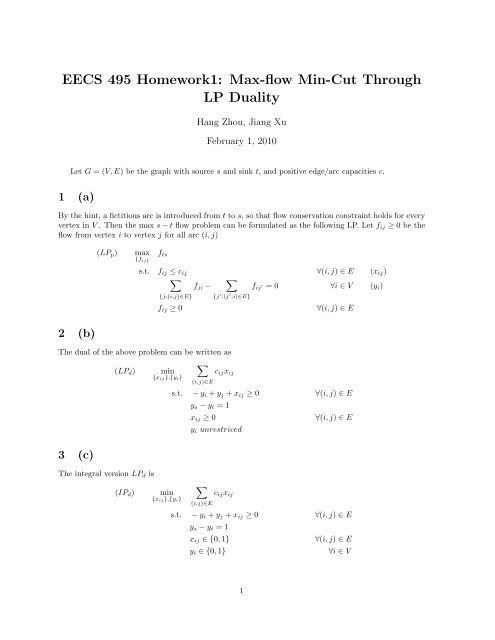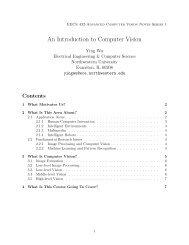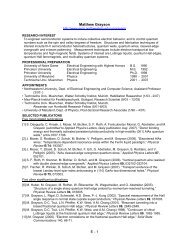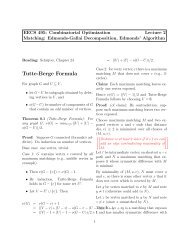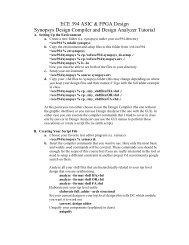EECS 495 Homework1: Max-flow Min-Cut Through LP Duality
EECS 495 Homework1: Max-flow Min-Cut Through LP Duality
EECS 495 Homework1: Max-flow Min-Cut Through LP Duality
Create successful ePaper yourself
Turn your PDF publications into a flip-book with our unique Google optimized e-Paper software.
<strong>EECS</strong> <strong>495</strong> <strong>Homework1</strong>: <strong>Max</strong>-<strong>flow</strong> <strong>Min</strong>-<strong>Cut</strong> <strong>Through</strong><br />
<strong>LP</strong> <strong>Duality</strong><br />
Hang Zhou, Jiang Xu<br />
February 1, 2010<br />
Let G = (V, E) be the graph with source s and sink t, and positive edge/arc capacities c.<br />
1 (a)<br />
By the hint, a fictitious arc is introduced from t to s, so that <strong>flow</strong> conservation constraint holds for every<br />
vertex in V . Then the max s − t <strong>flow</strong> problem can be formulated as the following <strong>LP</strong>. Let fij ≥ 0 be the<br />
<strong>flow</strong> from vertex i to vertex j for all arc (i, j)<br />
2 (b)<br />
(<strong>LP</strong>p) max<br />
{f ij}<br />
fts<br />
s.t. fij ≤ cij ∀(i, j) ∈ E (xij)<br />
�<br />
fji −<br />
�<br />
fij ′ = 0 ∀i ∈ V (yi)<br />
{j:(i,j)∈E}<br />
{j ′ :(j ′ ,i)∈E}<br />
The dual of the above problem can be written as<br />
�<br />
(<strong>LP</strong>d) min<br />
{xij},{yi}<br />
3 (c)<br />
The integral version <strong>LP</strong>d is<br />
(IPd) min<br />
{xij},{yi}<br />
fij ≥ 0 ∀(i, j) ∈ E<br />
(i,j)∈E<br />
cijxij<br />
s.t. − yi + yj + xij ≥ 0 ∀(i, j) ∈ E<br />
ys − yt = 1<br />
xij ≥ 0 ∀(i, j) ∈ E<br />
yi unrestriced<br />
�<br />
(i,j)∈E<br />
cijxij<br />
s.t. − yi + yj + xij ≥ 0 ∀(i, j) ∈ E<br />
ys − yt = 1<br />
xij ∈ {0, 1} ∀(i, j) ∈ E<br />
yi ∈ {0, 1} ∀i ∈ V<br />
1
IPd has an interpretation as a min s − t problem. Let (X1, X2) be a s − t cut of G where s ∈ X1 and<br />
t ∈ X2. Let yi = 1 if vertex i ∈ X1; yi = 0 if i ∈ X2. (It is easy to see that ys = 1 and yt=0.) Then<br />
xij = 1 only when (i, j) ∈ X1 × X2. Therefore, the objective in IPd is exactly the capacities of a s − t<br />
cut. The solution to this problem must be a min s − t cut.<br />
Since it is easy to see that both <strong>LP</strong>p and <strong>LP</strong>d are feasible and bounded, we have <strong>LP</strong>p = <strong>LP</strong>d by<br />
Strong <strong>Duality</strong>. On the other hand, we have IPd ≥ <strong>LP</strong>d due to integrality gap. Therefore, we have<br />
IPd ≥ <strong>LP</strong>d = <strong>LP</strong>p, i.e. the max s − t <strong>flow</strong> lower bounds the min s − t cut.<br />
4 (d)<br />
Without loss of generalities, we add the constraint of yi ≥ 0 to <strong>LP</strong>d. This is okay since it is only the<br />
difference between yi and yj matters in <strong>LP</strong>d. Let the resulting problem be <strong>LP</strong> ′ d .<br />
(<strong>LP</strong> ′ d) min<br />
{xij},{yi}<br />
�<br />
(i,j)∈E<br />
cijxij<br />
s.t. − yi + yj + xij ≥ 0 ∀(i, j) ∈ E<br />
ys − yt = 1<br />
xij ≥ 0 ∀(i, j) ∈ E<br />
yi ≥ 0 ∀i ∈ V<br />
We need to show that <strong>LP</strong> ′ d is integral, i.e. the polytope is integral. We will show this by showing that<br />
its constraint matrix is totally unimodular (TUM).<br />
can be written in the form of [X, Y ], where X corresponds to columns of<br />
The constraint matrix of <strong>LP</strong> ′ d<br />
xij variables and Y corresponds to columns of yi variables. It is easy to see that X is an identity matrix<br />
and Y is the incidence matrix of a directed graph, which is know to be totally unimodular. Furthermore,<br />
the concatenation of a TUM matrix and an identity matrix is TUM. Therefore, the constraint matrix of<br />
<strong>LP</strong> ′ d is TUM. Thus, <strong>LP</strong> ′ d is integral, and <strong>LP</strong>d is also integral. This concludes that max s-t <strong>flow</strong> equals<br />
the min s-t cut .<br />
2


